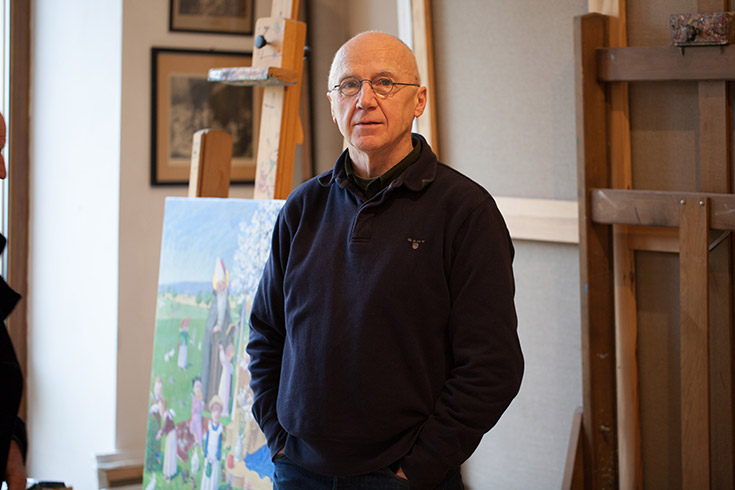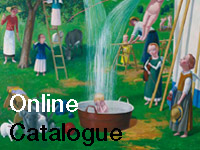Jan Knap

* 1949
“The reader completes the work,” wrote Charles Péguy, reminding us of his or her great responsibility. As if to say that a work of art too is made by two people: the one that creates it and the one that looks at it. For this special cooperation too, Knap’s painting concerns the present and doesn’t want to be shut away in a museum. It is an experience of the secret of living: we are in a creation that makes us. As a contemporary iconographer, the artist “writes” his images in a simple (not an easy) way and in one understandable for everyone, but as an ex-pupil of Joseph Beuys (1921-1986) and Gerhard Richter (1932) he does so in a conceptual way, attributing to each element of the composition a precise symbolic value.
For over thirty years Knap has proposed a revolution in looking, rather as the Nazarene painters had tried to do in Rome in the early nineteenth century. They were all Germans, young and romantic; in 1826 Joseph von Führich, a Bohemian like Knap, was to join their movement too; they rebelled against academic Classicism and renewed painterly language on religious and patriotic bases, looking to the painters of the Italian Quattrocento. In his paintings, as in Byzantine icons, there is not action but contemplation: he does not talk about the Kingdom of God, but makes it present as a living experience of beauty and happiness. What do we see, then? Almost always a watering can (it contains the water that cleanses, purifies, refreshes and saves), many musical instruments (strings, woodwind or percussion sound out the harmony of the cosmos), sheep and white rabbits (obedience is fruitful), a father, a mother, a few children, a pair of red shoes, because the family is sacred when it is a place of love, but those who begin to love must be ready to suffer and red shoes – like those that popes wear – are the symbol of those who walk on this earth as pilgrims and witnesses, to shed their blood for another’s life. In Knap’s pictures everything is a sign: the apple tree with red apples indicates the biblical tree of good and evil, while the ladder to pick the fruit of knowledge recalls the one that appeared in a dream to Jacob (Gen. XXVIII, 12-17) and that connects the visible world and the invisible one. Therefore, through the artist’s work, we are all called to regain this primordial vision, an intuition of beauty, a foreboding of harmony, an experience of joy and peace.
Colour too in Knap’s work is not just a means of decoration, but is a manifestation of the transcendent world: white for innocence, blue for divine life, red for love in action, brown for the earth, green for the soul, yellow for the light of God, as in Russian icons. Knap’s entire production is a vision and his art is loyalty to it. It is not formed a priori, in a laboratory suspended from the world, but is born in attention to what is behind appearance. It is not a dream, ideology or hallucinatory recklessness. The artist’s vision concerns the truth, which is always unpredictable, outside our norm and our measures; however, in a time marked by subjectivism and fundamentally irrational like ours, Knap and truth risk being estranged.
Indeed, as long ago as the time of the Academy in Düsseldorf, the painter challenged the conceptual and mannerist idiom according to which, after Marcel Duchamp, everything is a work of art, and after Joseph Beuys we are all artists. In 1979, while living in New York, he founded the “Normal” group with Milan Kunc and Peter Angermann, promulgating in times above suspicion the idea of a painting that meditates on the canons of beauty. From 1982 to 1984 he studied theology in Rome, from 1984 to 1989 he worked in Cologne, and from 1989 to 1992 he moved to Modena. Lastly, he left Italy and returned to Chrudim, in the Czech Republic, where he was born in 1949. Going over the biography of this unique and inimitable artist is right, in order to get in the best way possible into his art itself. His work reflects the many experiences in the United States and Italy, Germany and the Czech Republic, and clearly shows the richness and uniqueness of his artistic style. Knap uses a transcendental language in a disarming and moving way. He awakens supernatural nostalgias even in the least willing hearts and paints a nature in which the innocence of purity reigns.
Solo Exhibitions (selection)
1985 Jan Knap. Galerie Ilverich, Düsseldorf
1985 Jan Knap. Neue Bilder. Galerie Hans Jürgen Müller, Köln
1986 Jan Knap. Freude ist die wahrheit. Galerie Paul Maenz, Köln
1987 Jan Knap. Tekeningen. Galerie Wanda Reiff, Maastricht, NL
1987 Jan Knap. Galería La Máquina Española, Sevilla
1988 Jan Knap. Holly Solomon Gallery, New York
1988 Galleria Toselli, Milano
1988 Galerie Wanda Reiff, Maastricht
1989 Jan Knap. Aquarelle und Bilder. Galerie Gawlik&Schrom, Wien
1989 Galerie Ryszard Varisella, Frankfurt/Main
1989 Forum Hamburg (s /with Galleria Toselli)
1989 Jan Knap. Galleria Toselli, Milano
1990 Jan Knap. Associazione Culturale Piano Nobile, Perugia
1990 Galerie Bilinelii, Brussel
1990 Fiera d´Arte Attualissima. Firenze ( s/ with Galleria Toselli)
1990 Jan Knap. Obrazy. GHMP, Staroměstská radnice, Praha
1991 Jan Knap. Studio d´Arte Raffaelli, Trento. Itálie
1991 Jan Knap. Schilderijen - Werken op papier.Galerie Wanda Reiff, Maastricht
1992 Jan Knap. Galleria Toselli, Milano
1993 Galleria Toselli, Milano
1993 Galleria Chisel, Genova/Italy/ (s / with H.T. Fridjonsson)
1994 Gallerie Mot & Van den Boogaard, Brussel
1994 Jan Knap. Obrazy. Galerie Caesar, Olomouc
1994 Jan Knap. Obrazy a kresby. Galerie Ruce, Praha
1994 Jan Knap. Kresby. Galerie Na bidýlku, Brno
1995 Galerie Kaess-Weiss, Stuttgart
1995 Art Frankfurt (Galerie Kaess-Weiss)
1995 Art Chicago (Galerie Kaess-Weiss).
1995 Art Basel (Galerie Kaess-Weiss)
1995 Galerie Ve dvoře, Veselí na Moravě
1995 Jan Knap. Galerie Velehrad, Olomouc
1995 Jan Knap. Kresby. Galerie Ruce, Praha.
1996 Jan Knap. Schilderijen en tekeningen 1984–1996. Centraal Museum Utrecht, NL
1996 Jan Knap. Gemälde und Zeichnungen 1984–1996.
1996 Stădtische Ausstellungshalle Galerie im Karmeliterkloster, Frankfurt am Main, D
1997 Jan Knap. Antonio Colombo Arte Contemporanea, Milano
1997 Galerie Planá, Planá u Mariánských lázní
1997 Jan Knap. Sio Galeria, Barcelona
1997 Jan Knap. Obrazy, kresby. Výstavní síň Sokolská 26, Ostrava
1997 Jan Knap. Opere scelte. Arte 3, Trieste
1998 Jan Knap. Albrecht Dürer Gesellschaft, Kunstverein Nürnberg
1998 Jan Knap. Kunstverein Hof
1998 Jan Knap. Bilder aus den Jahren 1985–98. Kunstverein Lingen
1998 Jan Knap. Fondazione Stelline, Milano
1998 Jan Knap. Studio d´Arte Raffaelli, Trento
1998 Jan Knap. Tři obrazy a řada kreseb. Galerie V. Špály, Praha
1999 Jan Knap. Sperone – Westwater Gallery, New York
1999 Jan Knap. „Vánoční“ (obrazy). Galerie V kapli, Bruntál
2000 K2. Konrad Klapheck. Jan Knap. Cà di Frà, Milano
2000 Jan Knap. Galleria di via Eugippo e ex chiesetta di Sant´Anna, Galleria d´Arte Moderna, San Marino
2001 Jan Knap. Galleria Toselli, Milano
2002 Jan Knap. Obrazy, kresby, grafiky. Galerie ad astra, Kuřim
2002 Jan Knap. Melodia Ordinata. Galleria Claudio Poleschi Arte Contemporeanea, Lucca
2002 Jan Knap. Studio Simonis, Paris (listopad / November)
2003 Jan Knap. 3G Arte Contemporanea, Udine
2003 Jan Knap. Ovvero l´elegia pittorica del quotidiano. Galleria Giampiero Biasutti, Torino
2003 Jan Knap. Il luogo degli angeli. Palazzo del Panni, Arco
2004 Jan Knap. Galleria Toselli, Milano
2005 Jan Knap. Sospeso. 2000&Novecento Galeria d´Arte , Reggio Emilia
2005 Jan Knap. Istituto Culturale Ceco (České centrum), Roma
2006 Jan Knap. I giardini degli anni felici. Galleria Il polittico. Roma
2006 Jan Knap. Obrazy, kresby. Galerie Ad astra, Kuřim
2007 Jan Knap. Obrazy, kresby, grafika. Galerie Art, Chrudim
2007 Jan Knap. Pittura angelica. Galleria Giampiero Biasutti, Torino
2007 Jan Knap. Galerie Caesar, Olomouc
2008 Jan Knap. Opere recenti. Studio d´Arte Raffaelli, Trento
2008 Jan Knap. Galleria Civica d´arte Moderne - Palazzo Cilliola, Spoleto
2008 Jan Knap. Duetart Gallery, Varese
2009 Knap | Minuesa | Vitale - La Quieta Visione. Mandelli Arte, Seregno
2010 Jan Knap. La famiglia è la patria del cuore. Campione D'italia
2010 Jan Knap. La metafisica del quotidiano. ZONCA & ZONCA, Milano
2010 Jan Knap. Paintings, pastels & watercolours. Ornis A. Gallery, Utrecht, Netherlands
2010 Jan Knap. Obrazy. Galerie ad astra, Kuřim
2011 Jan Knap. Galerie Havelka, Praha
2013 Jan Knap. Obrazy. Galerie Petr Novotný, Praha
Collections
Safn, Reykjavik; The Living Art Museum, Reykjavik, Iceland
Centraal Museum, Utrecht
Deutsche Bank
Museum Boymans-van Beuningen, Rotterdam
Gian Enzo Sperone, Roma
Sperone–Westwater Gallery, New York
Collection David Hockney;
P. Giuliano, Milano
Verga, Cadorago
A. Cardilo
Sandres, Amsterdam
Mimmo Paladino, Milano
Peter&Roz Bonerz, Los Angeles
Carla Coppo, Milano
P. Consolandi, Milano
Ahmadpour Massound, Modena
Private collections Czech Republic, Slovakia, Belgium, Netherlands, Chile, Italy, Japan, Germany, USA, Venezuela, Iceland, Switzerland, Austria


